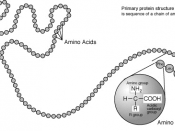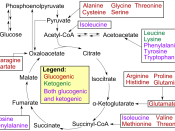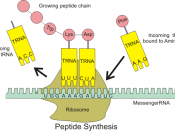Protein Synthesis is the process whereby DNA (deoxyribonucleic acid) codes for the production of essential proteins, such as enzymes and hormones. Proteins are long chains of molecules called amino acids. Different proteins are made by using different sequences and varying numbers of amino acids. The smallest protein consists of fifty amino acids and the largest is about three thousand amino acids long. Protein synthesis occurs on ribosomes in the cytoplasm of a cell but is controlled by DNA located in the nucleus.
Protein synthesis is a two-part process that involves a second type of nucleic acid along with DNA. This second type of nucleic acid is RNA, ribonucleic acid. RNA differs from DNA in three main respects. First, the sugar units in RNA are ribose as compared to DNA's deoxyribose. Because of this difference, RNA does not bind to the nucleotide base Thymine (T), instead, RNA contains the nucleotide base Uracil (U) in place of T.
(RNA also contains the other three bases: Adenine (A), Cytosine (C) and Guanine (G). Secondly, RNA, unlike DNA is a single stranded molecule and is therefore not bonded to a complimentary base.
The third difference between RNA and DNA is that there are three different types of RNA, mRNA (messenger RNA), tRNA (transfer RNA) and rRNA (ribosome RNA). mRNA carries the genetic code (instructions how to assemble the protein) from the DNA in the nucleus to ribosomes in the cytoplasm. tRNA picks up and transfers amino acids from cytoplasm to the mRNA on the ribosomes and is shaped similar to a cloverleaf. rRNA forms a structural part of ribosome that helps join the amino acids together form a protein.
DNA is a giant twisted molecule made up of many nucleotides linked together resembling a double helix. It provides a base triplet, a sequence of...



Mistake
There's an error in the fifth paragraph, second line from the top, first word. Its supposed to read "nucleus" not "nucleolus". Its a pretty major error.
0 out of 0 people found this comment useful.